Website molletvalles.cat Area 10.8 km² Area code 08100 | Demonym(s) Molletà Elevation 65 m Population 51,719 (2014) Local time Thursday 12:06 AM | |
 | ||
Weather 10°C, Wind W at 8 km/h, 81% Humidity | ||
Mollet del Vallès ([muˈʎɛd dəɫ βəˈʎɛs]) is a municipality in the comarca of the Vallès Oriental in Catalonia, Spain. It is situated in the valley of the Besòs river, and is an important communications hub from Barcelona towards the north: the AP-7 Motorway passes through the municipality, as do the RENFE railway lines to Vic and Puigcerdà and to Girona and Portbou. The town is also served by the C-17 highway (formerly N-152).
Contents
- Map of Mollet del VallC3A8s Barcelona Spain
- 10th Century
- 12th Century
- From 15th to 18th century
- Sites of interest
- Known characters
- Twin towns
- References
Map of Mollet del Vall%C3%A8s, Barcelona, Spain
Mollet del Vallès has a number of buildings in the modernista and noucentista styles. The studio-museum of the painter Abelló displays modern Catalan art.
Shooting at the 1992 Summer Olympics was carried out in Mollet del Vallès; the range has been reused for the 1998 ISSF World Shooting Championships.
10th Century
In the middle of the 10th century, Mollet was a little center of population that depended on the bishop of Barcelona.
12th Century
Of the medieval past of Mollet, there is only remaining the romanic church of Santa Maria de Gallecs
From 15th to 18th century
Mollet (which back then also included Parets) didn't raise the population until the 17th century, then, a new church was built, but as ruling a town with 3 churches was hard, there were constant conflicts, which concluded with the separation of Parets.
Sites of interest
The Abelló Museum is a municipal art museum located in Mollet del Vallès, in El Vallès Oriental.[1] Opened on 29 March 1999, its principal collection comprises pieces from artist and collector Joan Abelló, which donated his collection to the city in 1996, creating the Joan Abelló Foundation, an independent organisation of the Mollet del Vallès Town Council. The museum is located in an Art Nouveau-style building from 1908, of which only the façade has been preserved.
